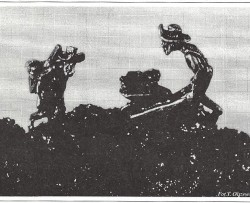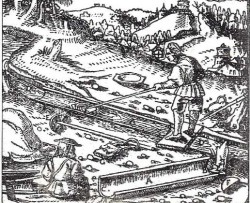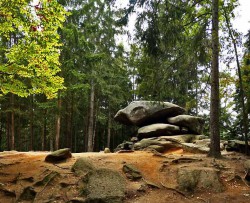Why Walloons?
 Walloons
- the Roman people, who arrived during conquest of Gaul by the Romans
and remained in the area, which proved rich in natural resources, in
what is now Belgium, Northern France, the Saar. They
were professional miners and processed natural resources, including
from the exploitation of silver, gold and precious stones. Thanks
to this, they were much appreciated at all courts, princely, royal
and imperial. In
the Middle-Ages there were few of them. They
formed
a special caste of people, possessing secret knowledge, like
alchemists, and astrologers. They
had a big influence on the rulers. They
were called engineers. They
did not carry out hard physical
work, but took samples instead and evaluated the contents of
deposits. Only
later all those who participated in the work of mining, regardless of
nationality, came to be called Walloons, even if they had nothing in
common with these Roman people. Anyone
searching for treasures was called a Walloon.
Walloons
- the Roman people, who arrived during conquest of Gaul by the Romans
and remained in the area, which proved rich in natural resources, in
what is now Belgium, Northern France, the Saar. They
were professional miners and processed natural resources, including
from the exploitation of silver, gold and precious stones. Thanks
to this, they were much appreciated at all courts, princely, royal
and imperial. In
the Middle-Ages there were few of them. They
formed
a special caste of people, possessing secret knowledge, like
alchemists, and astrologers. They
had a big influence on the rulers. They
were called engineers. They
did not carry out hard physical
work, but took samples instead and evaluated the contents of
deposits. Only
later all those who participated in the work of mining, regardless of
nationality, came to be called Walloons, even if they had nothing in
common with these Roman people. Anyone
searching for treasures was called a Walloon.
 From
the documents we know that Walloons already had worked for the
princes of the Piast dynasty in the region of the Sudetes as early as
the 11th century. In
the basin of the Szklarka and Kamienna rivers, as well as the High
Jizera Ridge, not only had they found deposits of gold and precious
stones, but also discovered deposits of pyrites (iron sulfides), used
in iron smelting as well as in the production of sulfuric acid. What
remains of
pyrite exploitation, are the several hundred years old mining pits in
the Zbójeckie Skały region. Whereas, at the mouth of the Szklarska
Struga and Kamienna rivers, there are the foundations of the old
sulfuric acid plant.
From
the documents we know that Walloons already had worked for the
princes of the Piast dynasty in the region of the Sudetes as early as
the 11th century. In
the basin of the Szklarka and Kamienna rivers, as well as the High
Jizera Ridge, not only had they found deposits of gold and precious
stones, but also discovered deposits of pyrites (iron sulfides), used
in iron smelting as well as in the production of sulfuric acid. What
remains of
pyrite exploitation, are the several hundred years old mining pits in
the Zbójeckie Skały region. Whereas, at the mouth of the Szklarska
Struga and Kamienna rivers, there are the foundations of the old
sulfuric acid plant.
Contrary to the fantasies, the greatest wealth were not gems, but glass-making, based on the deposits of quartz and numerous water courses, which became the foundation for the development of settlements. The most important base for treasure hunters was Lower Szklarska Poreba which was then called the Old Village. It was lying by the oldest route from Silesia to Bohemia. This was the route in the western Karkonosze, the earliest mentioned in medieval legends and writings, the so-called Czech Path. There were two important places in the area of Old Village. The first was the Eagle Rock with a chapel, in which each Walloon held a 7-day fasting and attending seven Masses, before heading out for work. Here, too, all his tools were consecrated; and after the Confession and Communion they promised a fair distribution of the goods found. Half went to Schaffgotsch, the owner of these lands. The other half had to be divided between the church and the finder. For their quarter, they were still obliged to give something for the alms, and to maintain the parish. Not much was left to them. Those who have not kept their promises were punished severely. Once a year, sentences were issued by the Reeve arriving from Jelenia Gora. These were issued in the Court Inn, in next to the old linden tree. The tree is still here. It is a monument of nature, and is called the court linden.
 Near
the chapel at the Orla Skala, there is a second place called the
Walloon signpost or "the sugar head", today known as theWobbling Stone (Chybotek). Pagan
sacrifices (bloody ones as well) were made there, as the Walloons
believed that they must win favors not only of heavenly powers, but
also of the powers of evil, according to the principle of "light
a candle for God and a candle-stub for Devil".
Near
the chapel at the Orla Skala, there is a second place called the
Walloon signpost or "the sugar head", today known as theWobbling Stone (Chybotek). Pagan
sacrifices (bloody ones as well) were made there, as the Walloons
believed that they must win favors not only of heavenly powers, but
also of the powers of evil, according to the principle of "light
a candle for God and a candle-stub for Devil".
Although the main "treasure" of Szklarska Poreba was always glass and not the gold - which was here and remains here so far. The largest quartz deposit found in Europe is the one that runs from near the Izerskie Garby next to the Jizera Crossroads, to the Kamieniecki Ridge. It has several kilometers long, and is still exploited without interruption since the early Middle-Ages. It is known that where quartz of hydrothermal origin is, at high pressure and with aqueous solutions at work the selection of different chemical compounds take place. Therefore, crystals in the Jizera Mountains are gold-bearing, although extracting them is not profitable anymore.
There are also precious stones here: crystals - like amethyst, mountain crystal and golden-and-brown smoky quartz. Garnets - pyrite and chalcopyrite, as well as pyrope - a red garnet gem. Sapphires, emeralds, rubies and zircons were also washed here. They are still here today - but small fragments mostly, more of a curiosity.
Walloon books have great historical value and prove the eternal human yearning to gain wealth. To this day, there is no shortage of amateurs looking for various minerals, as evidenced by the numerous collections, beautiful specimens of the treasures of our mountains in the Museum of the Earth and the Mineralogical Museum.
Author of the text: Juliusz Naumowicz - Grand Master of the Walloon
More in the texts of Juliusz Naumowicz, published in the bulletin "Under Szrenica:
![]() The Walloon treasure hunters (PL)
The Walloon treasure hunters (PL)
![]() Treasures
of our mountains (PL)
Treasures
of our mountains (PL)
![]() Walloon
truth continued (PL)
Walloon
truth continued (PL)
![]() Walloon
truth continued /2 (PL)
Walloon
truth continued /2 (PL)












